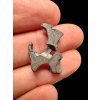Meteorite Pallasite Brenham 2,25g – Kansas, USA
Meteorite type: Pallasite, PMG-an
Locality: Kansas, USA
Weight: 2,25g
Dimensions: 2,1 x 1,4 x 0,3 cm
Year found: 1882
Total known weight: 4,3 tonnes
Surface treatment: cut, polished slice
Packing: Plastic box (5,8 x 3,8 x 1,6 cm)
| Category: | Brenham |
|---|---|
| By name: | Brenham |
| ? Type: | Stony-iron |
| ? Surface treatment: | Cut |
| Packaging: | In box |
Brenham – pallasite from USA
Brenham is a pallasite meteorite, remarkable for its composition and discovery history. It is mainly found near the town of Haviland in Kansas, USA, and is one of the largest pallasites ever discovered. Pallasites are a rare type of meteorite, composed of iron-nickel metal and olivine crystals, giving them their characteristic appearance.Brenham was discovered in 1882 by H.O. Shepard, who found several small fragments in a field near Haviland, Kansas. Later, in 1928, Daniel Moreau Barringer, known for his work on the Meteor Crater in Arizona, financed further exploration of the area, during which additional parts of the meteorite were found. The total recovered mass is approximately 4.3 tons.
The area around Haviland was repeatedly searched by enthusiasts and geologists. One of the largest fragments of the meteorite, weighing over 450 kg, was discovered in 2005 by Steve Arnold and Philip Mani. This discovery attracted significant media attention and popularity among meteorite collectors.







